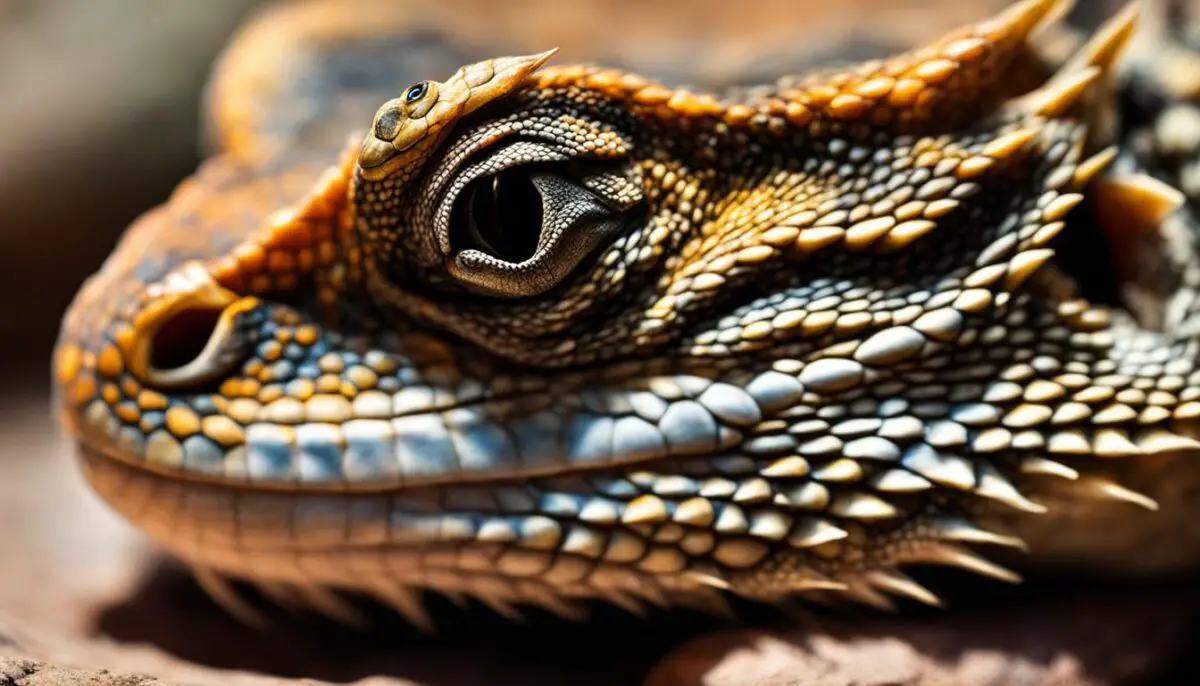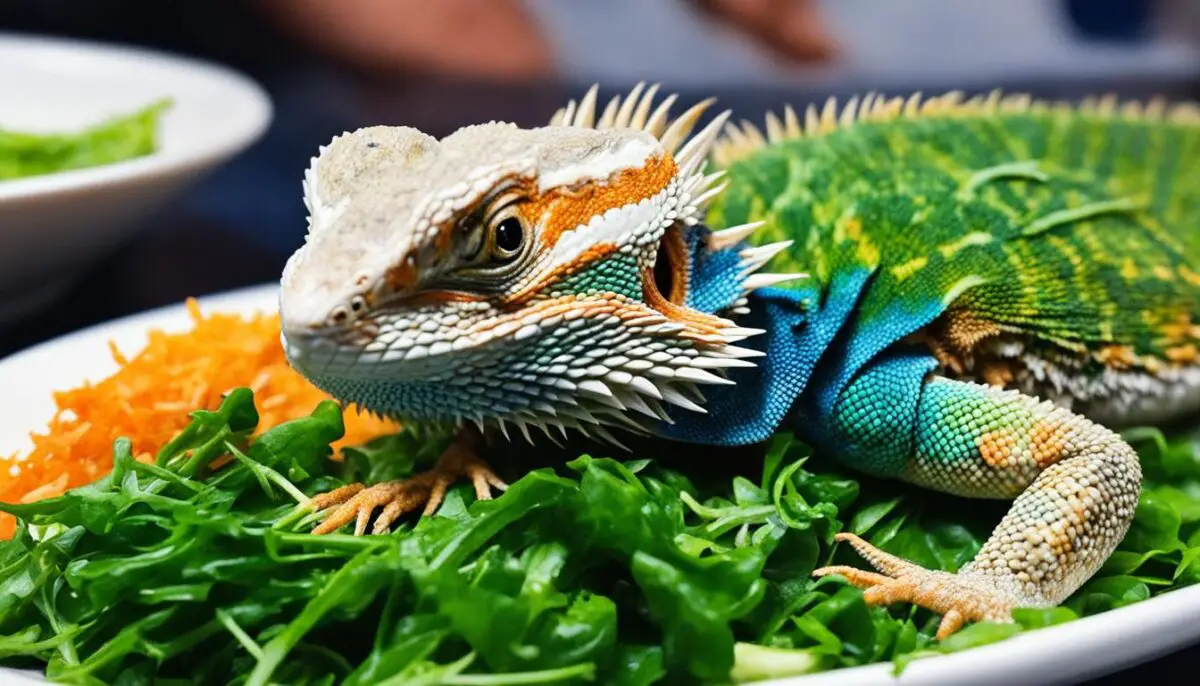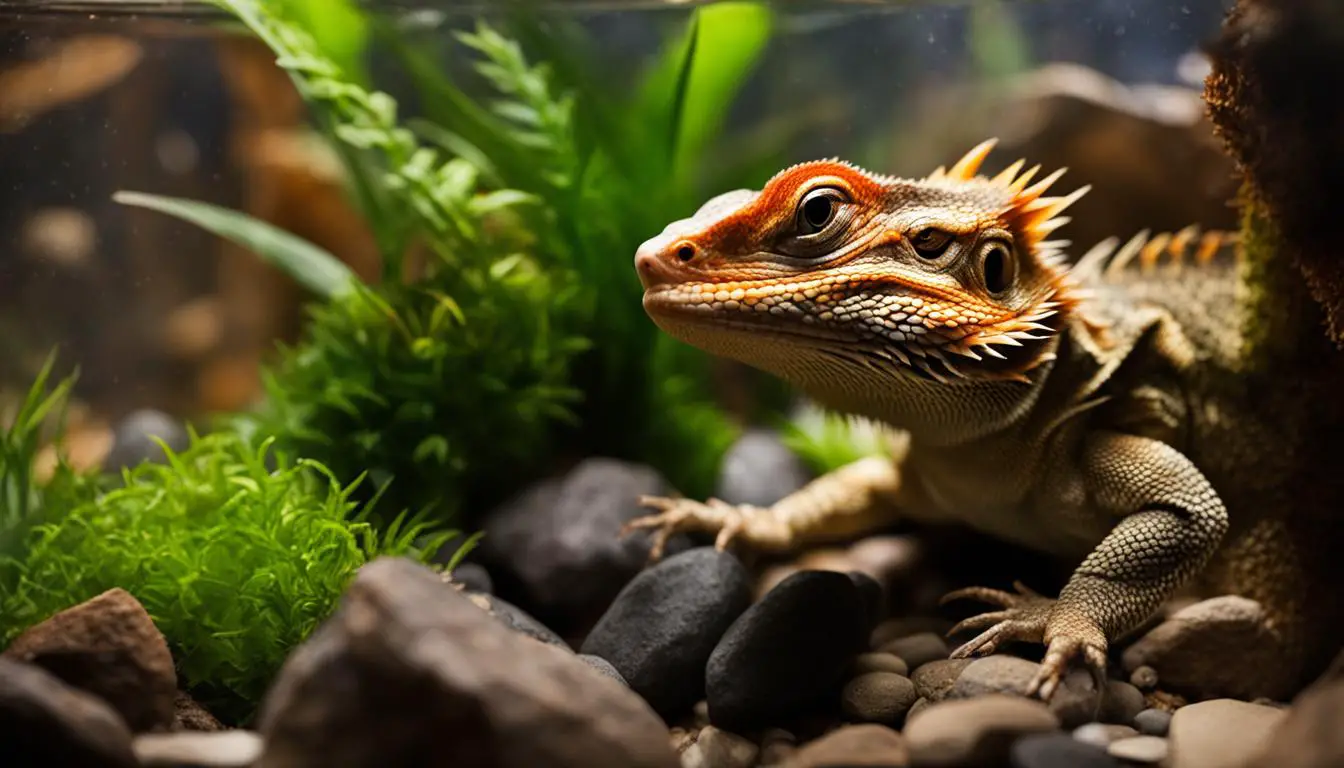Bearded dragons are intelligent, playful, and inquisitive pets. They have unique personalities and are known for their head nods and waving. However, it’s important to understand that even these docile creatures can experience fear and anxiety. In this article, we will explore tips and insights for soothing a scared bearded dragon and helping them regain comfort and security in their environment. We will also discuss signs of fear in bearded dragons and techniques for calming them.
Key Takeaways:
- Bearded dragons can experience fear and anxiety.
- Understanding their behavior and recognizing signs of fear can help you provide appropriate care.
- A safe and comfortable environment is essential for a scared bearded dragon.
- Establishing a calming routine can help alleviate fear and anxiety.
- Proper diet and nutrition contribute to a calm bearded dragon.
Understanding Bearded Dragon Behavior
Bearded dragons, known for their intelligence and playful nature, communicate through body language, providing insights into their emotions and behaviors. By understanding their behavior, you can recognize signs of fear in bearded dragons and employ effective techniques to calm them.
Bearded dragons express their emotions through a variety of gestures, including head bobbing, arm waving, and color changes. These behaviors can indicate fear or anxiety in these reptiles. It’s crucial to be aware of the signs of fear in bearded dragons, such as hiding, puffing up their beard, hissing, or attempting to escape.
Identifying these signs and interpreting your bearded dragon’s behavior is key to addressing their fear and providing them with the comfort and security they need. By recognizing these signs, you can take appropriate measures to soothe your scared bearded dragon and alleviate their anxiety.
Calming Techniques
When it comes to calming a scared bearded dragon, several techniques can be effective:
- Providing a safe hiding spot: Bearded dragons feel secure when they have a designated area where they can retreat. You can create hiding spots by adding rocks, branches, or commercial hiding caves within their enclosure.
- Maintaining a consistent environment: Bearded dragons thrive in a stable environment. Avoid sudden changes in their habitat, such as temperature or lighting, as these can trigger fear and stress.
- Gentle handling: Handle your bearded dragon with care and avoid making sudden movements. Gradually introduce handling sessions to build trust and familiarity, helping them overcome their fear over time.
By implementing these calming techniques, you can create a sense of security for your scared bearded dragon and gradually alleviate their fear.

Creating a Safe and Comfortable Environment
A safe and comfortable environment is crucial for a scared bearded dragon to feel secure and at ease. These reptiles rely on specific habitat conditions to thrive and reduce their anxiety. Here are some key factors to consider when creating a bearded dragon’s habitat:
- Temperature: Bearded dragons require a basking area with a temperature between 100-110°F (37-43°C) during the day and cooler areas around 80-85°F (27-29°C) at night. You can achieve this by using a reptile heat lamp or a ceramic heat emitter.
- Humidity: Maintain a humidity level of around 30-40% to prevent dehydration. Bearded dragons are desert dwellers, so they don’t require high humidity levels. Regular misting or a reptile humidifier can help achieve this.
- Lighting: Proper lighting is essential for bearded dragons as it helps with their digestion and calcium absorption. Provide them with a UVB light source for at least 10-12 hours a day. You can use a fluorescent tube or a mercury vapor bulb specifically designed for reptiles.
- Enclosure: Set up a spacious enclosure that allows your bearded dragon to move around comfortably. A 40-gallon tank or terrarium is suitable for an adult bearded dragon, while a 20-gallon one is ideal for young dragons. Ensure proper ventilation and secure locks to prevent any escape or injuries.
- Hiding Spots: Offer a variety of hiding spots within the enclosure to provide your scared bearded dragon with the option to retreat when feeling anxious or scared. You can use rocks, logs, or commercial reptile hides to create these safe spaces.
By providing the right habitat conditions and ensuring a consistent environment, you can significantly contribute to calming a scared bearded dragon and helping them feel secure.

Establishing a Calming Routine
Creating a calming routine is crucial for helping your scared bearded dragon feel safe and secure. By establishing consistent practices, you can alleviate their fear and anxiety over time. Here are some key steps to follow in order to create a soothing routine for your bearded dragon:
- Regular Feeding Times: Feed your bearded dragon at the same time each day to establish a sense of predictability. This will provide them with a routine and help them feel secure in their feeding habits.
- Gentle Handling Sessions: Set aside dedicated time for gentle handling sessions with your bearded dragon. Approach them calmly and use slow movements to avoid startling them. This hands-on interaction can help build trust and familiarity.
- Enrichment Activities: Provide a range of enrichment activities to stimulate your bearded dragon’s senses and keep them occupied. This can include introducing new toys, rearranging their enclosure, or creating a play area outside of their habitat. Engaging their curiosity can help divert their attention from fear and anxiety.
Remember to always observe your bearded dragon’s body language and take cues from their comfort level. Adjust the routine accordingly to ensure it suits their individual needs.
By incorporating these elements into your scared bearded dragon care routine, you can create a calming environment that promotes their well-being and reduces anxiety.
| Benefits of a Calming Routine: |
|---|
| 1. Reduces fear and anxiety in your bearded dragon |
| 2. Establishes a sense of security and predictability |
| 3. Builds trust and strengthens the bond between you and your pet |

Proper Diet and Nutrition for a Calm Bearded Dragon
When it comes to ensuring the well-being of your bearded dragon, proper diet and nutrition are essential. A balanced diet plays a crucial role in their overall health, including their emotional state. By providing a calm bearded dragon with the right nutrition, you can contribute to their sense of calm and well-being.
A bearded dragon’s diet should consist of a variety of insects, vegetables, and fruits. This ensures that they receive the essential nutrients they need to thrive. Insects such as crickets, mealworms, and Dubia roaches are excellent sources of protein for your bearded dragon.
Vegetables like kale, collard greens, and butternut squash are packed with vitamins and minerals, and they provide necessary fiber for proper digestion. Additionally, fruits like blueberries, strawberries, and papaya can be offered as occasional treats, adding variety to their diet.
It’s important to note that the diet of a scared bearded dragon may require special attention. Anxiety and stress can impact their appetite and digestion. Consider incorporating calming foods into their diet, such as chamomile flowers or mashed sweet potatoes. These natural remedies may help soothe a scared bearded dragon and provide additional nutritional benefits.
To ensure a balanced diet, it’s recommended to follow a feeding schedule and provide appropriately sized portions. Juvenile bearded dragons require more frequent feedings and a higher intake of live insects compared to adult dragons.
Table:
| Food Type | Feeding Frequency | Portion Size |
|---|---|---|
| Insects | Every day for juveniles, every other day for adults |
Number of insects equivalent to the space between their eyes |
| Vegetables | Every day | A handful of various vegetables |
| Fruits | 2-3 times per week as treats | 1-2 small pieces of fruit |
Acknowledging the individual needs of your bearded dragon is crucial. It’s important to monitor their diet, adjust portion sizes as needed, and consult with a veterinarian for specific dietary recommendations based on their age, health, and any potential anxiety issues.
Remember, a bearded dragon’s nutrition directly impacts their overall well-being. Providing them with a balanced diet filled with essential nutrients will not only support their physical health but also contribute to a sense of calm and happiness.

Veterinary Care for Scared Bearded Dragons
Regular veterinary care is essential for the health and well-being of bearded dragons, including those who may be scared or anxious. A knowledgeable reptile veterinarian can provide guidance on proper handling techniques, address any underlying health issues that may be contributing to their fear, and offer advice on creating an optimal environment for their specific needs. Seeking professional veterinary care can help ensure the long-term health and happiness of a scared bearded dragon.
When it comes to scared bearded dragons, a veterinarian with experience in reptile care is invaluable. They have the expertise to assess your dragon’s overall health and identify any underlying conditions that could be causing or exacerbating their fear. Additionally, they can offer guidance on how to safely handle a scared bearded dragon to avoid further stress.
H3: Understanding the Root Causes of Fear
There can be various reasons why a bearded dragon may be scared or anxious. It’s important to determine the underlying cause of their fear to provide appropriate veterinary care. Common causes of fear in bearded dragons can include:
- Environmental stressors such as insufficient heat or lighting
- Past traumatic experiences or mistreatment
- Health issues, such as pain or illness
- Unfamiliar or threatening stimuli in their surroundings
By conducting a thorough examination and discussing your bearded dragon’s behavior and habitat, a reptile veterinarian can help identify these root causes and work towards alleviating their fears.
Creating a Calm and Comfortable Environment
To help calm a scared bearded dragon, it’s crucial to create a safe and comfortable environment for them. This includes providing the right temperature and humidity levels, as well as ample hiding spots for privacy when they feel scared or overwhelmed.
A proper bearded dragon habitat should have:
- A well-maintained temperature gradient with a basking area
- Proper UVB lighting for their overall health
- Multiple hiding spots to give them a sense of security
- Avoidance of loud noises and sudden disturbances
| Environmental Aspect | Importance | Tips |
|---|---|---|
| Temperature gradient | Essential for thermoregulation and digestion | – Use a thermostat to maintain the appropriate temperature – Provide a basking spot with a temperature of 95-105°F (35-40°C) |
| UVB lighting | Crucial for the synthesis of Vitamin D3 and calcium absorption | – Use a UVB bulb specifically designed for reptiles – Replace the bulb according to the manufacturer’s recommendations |
| Hiding spots | Offer a sense of security and privacy | – Place branches, logs, or caves in the enclosure – Ensure hiding spots are easily accessible |
| Noise and disturbances | Avoid situations that may startle or stress your bearded dragon | – Keep their enclosure in a quiet area – Gently approach them to minimize unnecessary stress |
By optimizing their environment, you can create a comforting space that helps alleviate your bearded dragon’s fear and anxiety.
Remember, a scared bearded dragon may need some time to adjust to their new surroundings. Be patient and understanding as you provide them with the care and support they need.
Conclusion
When it comes to soothing a scared bearded dragon, patience and understanding are key. Each bearded dragon may have unique fears and anxieties, so it’s important to approach them with care and consistency. By creating a safe and comfortable environment, establishing a calming routine, providing a proper diet, and seeking veterinary care when necessary, you can help your bearded dragon overcome their fears and thrive in their surroundings.
Creating a safe and comfortable environment means ensuring the proper temperature, lighting, and habitat setup for your scared bearded dragon. This includes offering hiding spots, maintaining consistent conditions, and minimizing noise and disturbances. These measures can help alleviate their anxiety and make them feel secure.
In addition to the environment, establishing a calming routine is essential. This includes regular feeding times, gentle handling sessions, and providing enrichment activities. A predictable and nurturing routine can help your bearded dragon feel safe and build their trust.
Lastly, proper diet and nutrition play a crucial role in the emotional well-being of your bearded dragon. Offering a balanced diet of insects, vegetables, and fruits ensures they receive the essential nutrients they need to stay healthy and calm.
Remember, building trust and alleviating anxiety takes time and care. Approach your scared bearded dragon gently, provide positive reinforcement, and seek the guidance of a reptile veterinarian when needed. With your love and attention, you can create a loving bond with your bearded dragon and help them overcome their fears.
FAQ
Can bearded dragons feel fear?
Yes, bearded dragons can experience fear and anxiety. Despite their docile nature, it’s important to recognize the signs of fear in bearded dragons and provide them with comfort and security.
How can I tell if my bearded dragon is scared?
Signs of fear in bearded dragons may include hiding, puffing up their beard, hissing, or attempting to escape. They may also display changes in body language, such as head bobbing and arm waving.
How can I calm my scared bearded dragon?
You can calm a scared bearded dragon by providing a safe hiding spot, maintaining a consistent environment, and practicing gentle handling. Understanding their behavior and needs is essential to soothing their anxiety.
What should I do to create a safe environment for my scared bearded dragon?
Creating a safe environment for your scared bearded dragon involves setting up a proper enclosure, offering hiding spots, providing the right temperature and lighting conditions, and minimizing noise and disturbances.
How can I establish a calming routine for my scared bearded dragon?
You can establish a calming routine for your scared bearded dragon by implementing regular feeding times, gentle handling sessions, and providing enrichment activities that stimulate their senses and keep them occupied.
What should I feed my scared bearded dragon to promote calmness?
A balanced diet including a variety of insects, vegetables, and fruits is essential to support the overall well-being and emotional state of your bearded dragon. Providing the right nutrition can contribute to their sense of calm and well-being.
Should I seek veterinary care for my scared bearded dragon?
Yes, regular veterinary care is crucial for the health and well-being of all bearded dragons, including those who may be scared or anxious. A reptile veterinarian can provide guidance on proper handling techniques and address any underlying health issues causing fear.

